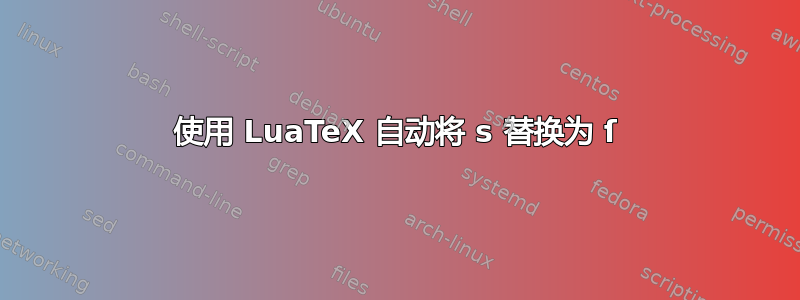
我正在寻找一种方法来将我的 LuaTeX 文档(最好是纯 LuaTeX 或 OpTeX)中的所有 s 替换为 ſ,除非:
- 它前面有另一个 s,
- 它位于单词的末尾。
所以它类似于基于规则将 s 替换为 ſ(长 s)但规则更少、更简单,并且使用简单。
我尝试了以下代码:
\fontfam[LM Fonts]
\directlua{%
function replace_s_with_long_s(input)
return input:gsub("s", "ſ"):gsub("ſſ", "ß")
end
callback.add_to_callback("process_input_buffer", replace_s_with_long_s)}
\lipsum[1]
\bye
运行该optex long-s.tex命令,但存在两个问题:
- lipsum 中的 s 被替换了(我希望替换只影响要排版的文本,而不是命令)
- 我不知道如何在 Lua 中匹配单词的最后一个字母(对于规则 2)。
作为参考,文本
pour qui sont ces serpents qui sifflent sur vos têtes
应该成为
pour qui ſont ces ſerpents qui ſifflent ſur vos têtes
理想情况下,解决方案不应依赖于文档中使用的特定字体。
答案1
它留下了一些边缘情况,但你可以从
\fontfam[LM Fonts]
\directlua{
--[[ A list of characters which indicate a word break ]]
local non_word_chars = {
[utf8.codepoint'.'] = true,
[utf8.codepoint','] = true,
[utf8.codepoint';'] = true,
--[[ Add more here as appropriate ]]
}
--[[ A list of node types which indicate a word break ]]
local non_word_ids = {
[node.id'glue'] = true,
[node.id'rule'] = true,
--[[ Add more here as appropriate ]]
}
local s = utf8.codepoint's'
local long_s = utf8.codepoint'ſ'
function replace_s_with_long_s(head)
local after_s = false
for n in node.traverse(head) do
local char, id = node.is_char(n)
if char == s then
local after = n.next
local after_char, after_id = node.is_char(n.next)
local is_end_of_word = after == nil or non_word_chars[after_char] or non_word_ids[after_id]
if not (after_s or is_end_of_word) then
n.char = long_s
end
after_s = true
elseif char or non_word_ids[id] then
after_s = false
end
end
return true
end
callback.add_to_callback("pre_shaping_filter", replace_s_with_long_s)}
\lipsum[1]
\bye
基本思想:避免process_input_buffer,否则您将转换输入而不是排版文本,从而导致与 类似的问题。相反,您可以使用在字体处理完成之前直接运行的回调来\lipſum迭代节点列表。然后,您只需找到将字段设置为 Unicode 代码点的字符节点。您可以跟踪是否已经在使用简单布尔值进行替换之后,但识别工作的结束更加棘手:此代码使用以下节点类型或字符的简单启发式方法,但列表可能应该扩展,并且根据语言的不同,单词的结尾可能会更复杂。pre_shaping_filter.chars
剩余的三个问题:
- 单词的结尾是什么?https://www.unicode.org/reports/tr29/#Word_Boundaries是 Unicode 中确定该问题的标准算法,但具体实现起来有些复杂。
- 组合标记应如何处理?例如,
ś也应该替换。目前,这取决于输入方式(预组合或分解),但它们可能应该以一致的方式处理。 s显式的内部内容\discretionary将被忽略。


